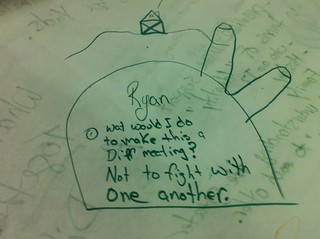“Not to fight with one another”
Art of Harvesting, Art of Hosting, Community, Conversation, Design, Facilitation, First Nations, Invitation, World Cafe
I was up north on the weekend, working with a small community that has been driven apart by a large and contentious decision. It doesn’t matter what it was, or what either side wanted – the result is the same result that happens in many small communities: people who are friends and neighbours shouting and fighting with each other.
The team I was working with are trying to reinvent the way this community is engaged. We used a lovely redux of Peter Block’s work to help frame our conversation about design and implementation. A few things stood out for this group with respect to Peter’s work.
Changing the room changes the conversation. We talked a lot about the fact that changing engagement starts in this room and in this moment because this room IS the community. When we dove in about what was missing from the way the community engages it was clear that the ownership piece was the biggest one. As in many community meetings the way people traditionally engage is with passion that is directed outward. There is an expectation that someone else needs to change. We joked about the sentiment that says “I’ll heal only after every else has healed!” It was a joke but the laughter was nervous, because that statement cuts close to the bone. So we DID change the room and decided to hold a World Cafe. gathered around smaller tables, paper in the middle, markers available for everyone to write with…
So how do you begin a meeting with people who are invited to take up the ownership of the outcome? I am not a fan of giving people groundrules, because as a facilitator it puts me in the position of enforcer, and gives people an out for how the behave towards one another. So instead we considered the question of what it looks like when people are engaged. What stood out is how people “lean in” to the centre of the conversation. So the question became, how do we get people to lean in right away and take ownership of the centre?
The solution was simple but was later revealed to have tons of power. At the outset of the cafe as I was introducing the process I gave the following instructions:
“That paper in the middle is for all of you to use, as are the markers. We want you each to record thoughts and insights that other need to hear about. So before we begin I invite you to pick up a marker and write your name in front of you. <people write their names>. Now I want to invite you to answer this question: what is one thing you can do to make sure that this meeting is different? Write your answer beneath your name.”
People took a moment to write their names and their commitments. And they shared them with each other at the table. That is how we began.
The first round of conversation proceeded as usual, but I noticed something very powerful in the second round. When everyone got up and moved around they took a seat in someone else’s place, and often the first thing they did was to read the name and the commitment that was in front of them. Can you imagine coming across the name of someone who you have a disagreement with only to see that they have written “I won’t fight anymore” beneath their name? The core team is now going through all of the tablecloths and making a list of the commitments that people made. Taken on their own, they form a powerful declaration of willingness.
People reported that this was the best meeting the community had in a long time. And it had a lot to do with this tiny intervention of public ownership for the outcomes.



Great story!!! Ria
Thank you, Chris. That was helpful.
Love it, Chris! I’ll remember this story.
Thank you so much for the simple idea, inclused in a very readable story!
I love the work that you do!